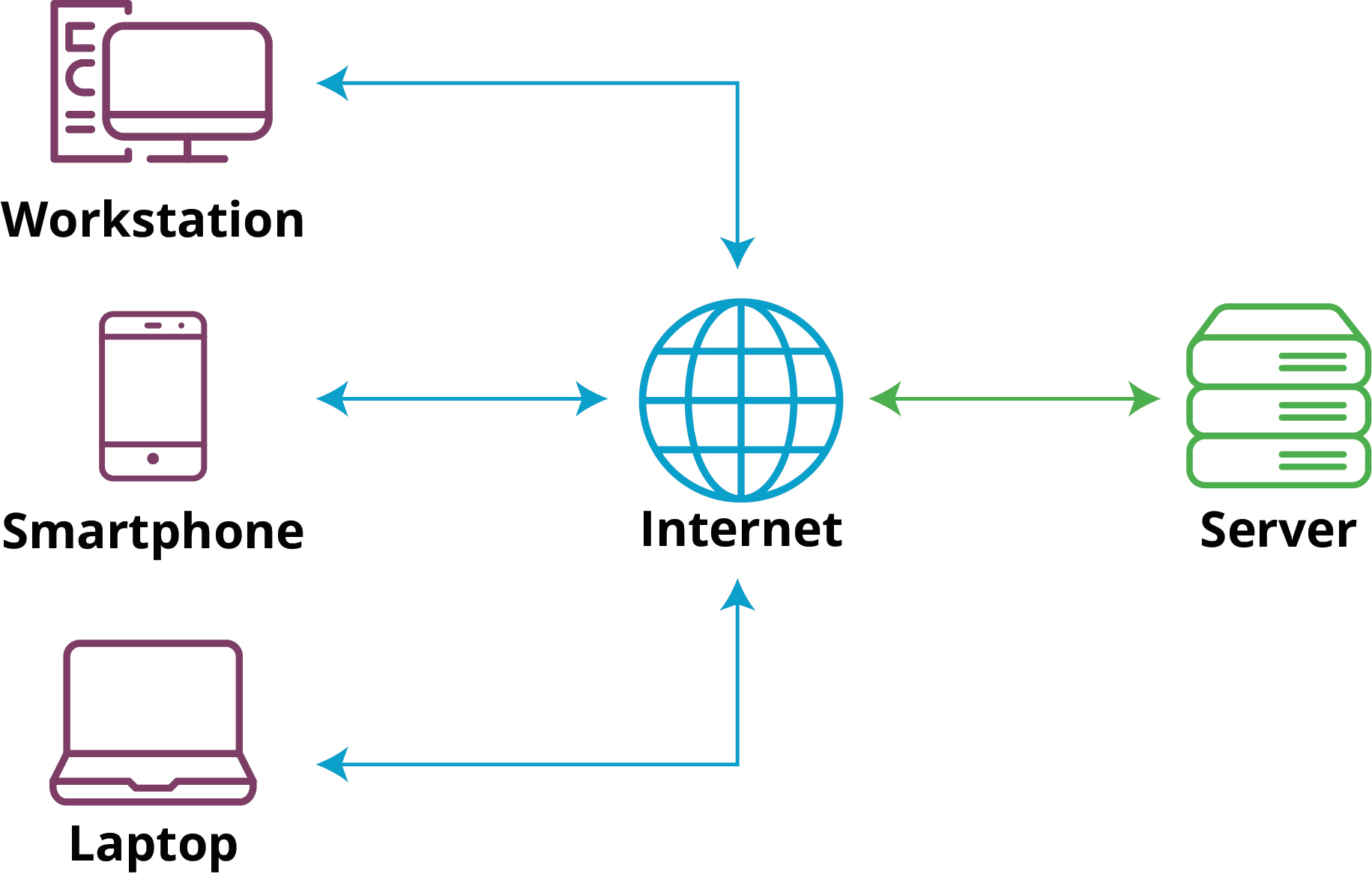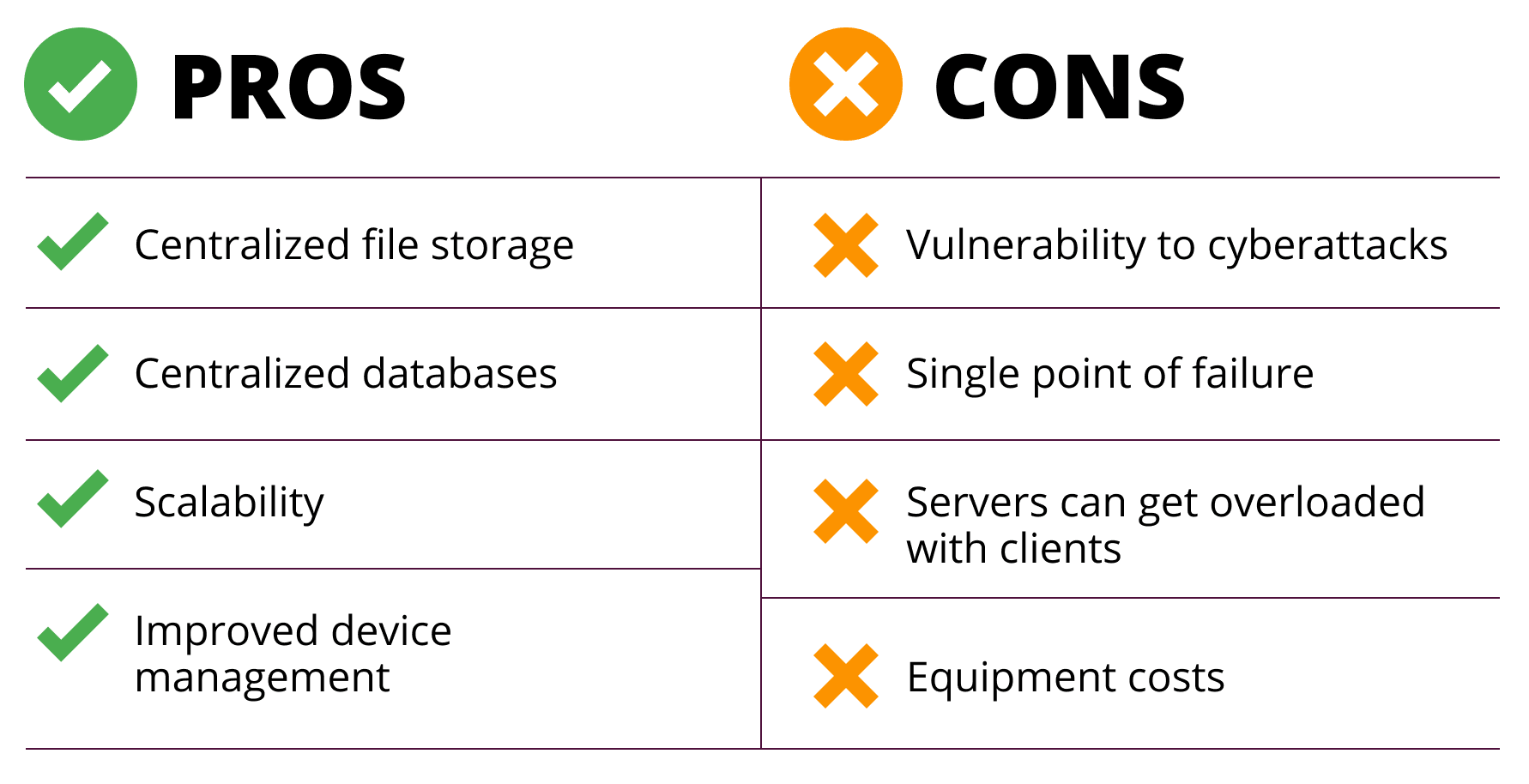Guide to Client-server Architecture or Model
Computer networks are continuously evolving, with new technologies being introduced almost every year. These technological innovations include cloud, blockchain, 5G, and satellite internet, just to name a few. For that reason, IT professionals and engineers should have a good grip on network fundamentals.
The client-server model, or client-server architecture, is one of the most important concepts of computer networks. Not only that, but the large majority of today’s networks rely on this exact model.
What Is Client-Server Architecture?
Client-server architecture is a type of computer network where multiple clients request and receive files and services from a centralized server over a local or internet connection. A client uses an application as an interface to connect to the server. After that, the server processes any further operations and information storage.
Take a look at the image below to better understand this concept:

How Does the Client-Server Model Work?
The client-server model works in three steps, as you can see below:
- The client, such as a workstation or smartphone, connects to the network using a physical or wireless LAN or internet connection.
- The client sends various requests to the server in order to submit, retrieve, or modify the data located on the server.
- The server processes each client request.
Furthermore, there are three basic layers to client-server architecture:
- The presentation layer is the part of the application that the user interacts with, also known as the user interface.
- The business logic layer represents the actual code of an application and connects and instructs the presentation and data layers.
- The data layer is made out of database tables and the logic required to operate on them.
Example of Client-Server Architecture
To better understand how this works in the real world, take a look at the client-server architecture example below:
You use a booking app on your phone. In the booking app, you enter your personal details and make a reservation. The app stores this information in its database.
So how does that translate to client-server architecture?
First, the app’s interface, located on the client, serves as a presentation layer. Then, the app’s functionality, located on the application server, serves as a business logic layer. Finally, the booking app’s database server functions as a data layer.
Why Use a Client-Server Network?
Organizations of all sizes rely on computers and computer networks to achieve their day-to-day tasks. To be effective, they need a system that makes it easy to collect, store, and process a lot of data.
This is where the client-server model shines, as it brings a higher level of management and processing power to computer networks, allowing businesses to boost efficiency and scale as necessary.
Client-server networks are a key concept to learn if you want to understand what enterprise architecture is.
Types of Client-server Networks
There are several types of client-server networks, including 1-tier architecture, 2-tier architecture, 3-tier architecture, and n-tier architecture. One way to describe the difference between them is by how they organize the presentation, business logic, and data layers.
1-tier architecture
In 1-tier architecture, the presentation, business logic, and data layers are all stored on a single device or a shared storage device. A good example is a desktop application that works offline and stores all its data on the same device it's running from.
2-tier architecture
In 2-tier architecture, the presentation and business logic layers are stored on the client while the data layer is stored on a server. So as long as the code of an application is fully executed on the client and some of the data is being stored in a remote database, that application fits the 2-tier architecture criteria. A desktop application that requires you to log into an online account is a good example.
3-tier architecture
The presentation layer is stored on the client, the business logic layer is stored on one server, and the data layer is stored on another server. For example, you use a smartphone app’s user interface to interact with an app while an application server executes most of the app’s code and a database server stores the data
N-tier architecture
In N-tier architecture, the presentation and data layers are left untouched, compared to the 3-tier architecture. The difference is that N-tier architecture splits the business logic layer into multiple layers to improve performance, management, and stability.
Pros and Cons of the Client-Server Architecture
Here are some pros and cons of the client-server model that you should be aware of:
Pros
- Centralized file storage makes it easier for multiple clients to share, store, and operate on files.
- Centralized databases improve data organization, security, and management.
- Server scalability allows for easier hardware and performance management as well as cost savings.
- Device management is more effective when done from a single server instead of individual clients.
Cons
- It’s easier to infect a single server than individual clients.
- Since centralized servers store the software and data, users lose all access if those servers fail.
- Too many client requests can overload the server, causing performance issues and service outages.
- Buying and running a server and networking equipment is an additional expense.

Dedicated Servers and the Client-Server Model
You can use several different server solutions to set up a client-server model. Some of them include dedicated servers, VPS servers, and cloud servers.
Here are some benefits you can expect if you use a dedicated server for your client-server network:
- Very high privacy and security potential.
- Fully customizable software and hardware.
- Very high level of monitoring, control, and remote access.
- Virtually limitless storage capacity potential.
For a hassle-free enterprise web hosting experience, you should consider a fully managed dedicated server and let your service provider take care of the server setup, administration, and support.
Final Thoughts
The client-server architecture is a fundamental networking concept that’s widely used in various industries. It allows multiple clients to request and receive files and services from a centralized server, providing benefits such as centralized file storage, improved data organization, and better management.
There are some drawbacks, however, including vulnerability to cyberattacks, being a single point of failure, and getting overloaded with requests. But the good news is that you can address most of these drawbacks with the proper solutions to various degrees. For example, you can use scaling, clustering, and load balancing to mitigate the single point of failure and request overload problems.
To set up a client-server network, you can use various solutions, such as dedicated servers, VPS servers, and cloud servers. Dedicated servers benefit from high privacy and security, fully customizable software and hardware, and a virtually limitless storage capacity potential.
Overall, understanding the client-server model is crucial for IT professionals and engineers to manage and maintain computer networks effectively.
Liquid Web Dedicated Hosting
If you’re looking for a high-performing and secure dedicated server, you’ve come to the right place. You can get all you need from Liquid Web's dedicated server plans. Let us take your hosting experience to the next level.

Joseph Molloy
Liquid Web Security Operations tech Joseph spends his days cleaning up malware and doing his part to keep the Internet safe. He is interested in all things Linux and always looking for something new to learn. In addition, he enjoys cooking and playing guitar, is an avid horror and sci-fi reader, and is a fan of black metal music.
Keep up to date with the latest Hosting news.



